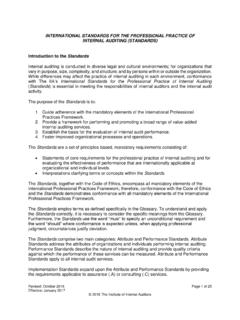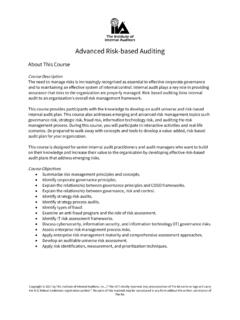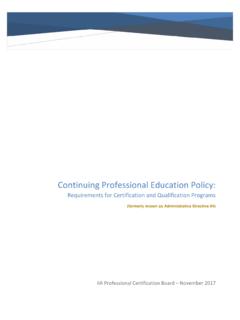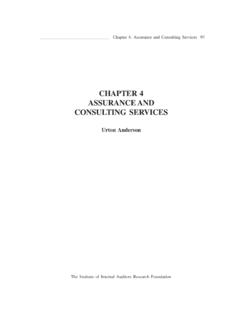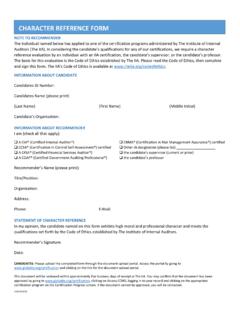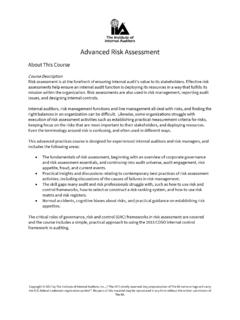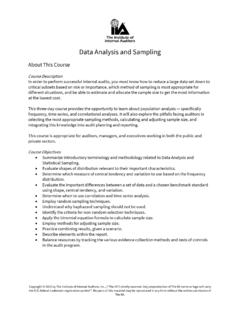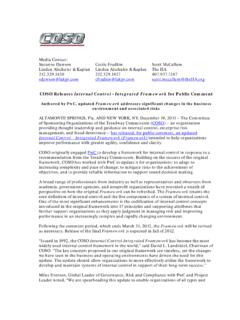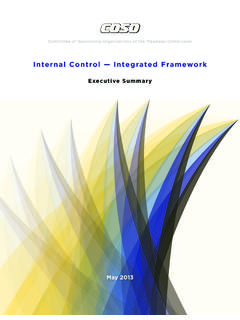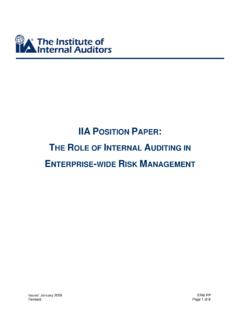Transcription of CHAPTER 1 INTERNAL AUDITING: HISTORY, EVOLUTION, …
1 _____ CHAPTER 1: INTERNAL auditing : History, Evolution, and Prospects 1. CHAPTER 1. INTERNAL auditing : HISTORY, EVOLUTION, AND PROSPECTS. Sridhar Ramamoorti The Institute of INTERNAL Auditors Research Foundation Disclosure Copyright 2003 by The Institute of INTERNAL Auditors, 247 Maitland Avenue, Altamonte Springs, Florida 32701-4201. All rights reserved. Printed in the United States of America. No part of this publication may be reproduced, stored in a retrieval system, or transmitted in any form by any means electronic, mechanical, photocopying, recording, or otherwise without prior written permission of the publisher. The IIA publishes this document for informational and educational purposes. This document is intended to provide information, but is not a substitute for legal or accounting advice. The IIA does not provide such advice and makes no warranty as to any legal or accounting results through its publication of this document. When legal or accounting issues arise, professional assistance should be sought and retained.
2 The professional Practices Framework for INTERNAL auditing (PPF) was designed by The IIA Board of Directors'. Guidance Task Force to appropriately organize the full range of existing and developing practice guidance for the profession. Based on the definition of INTERNAL auditing , the PPF comprises Ethics and Standards, Practice Advisories, and Development and Practice Aids, and paves the way to world-class INTERNAL auditing . This guidance fits into the Framework under the heading Development and Practice Aids. ISBN 0-89413-498-1. 02404 01/03. First Printing 2 Research Opportunities in INTERNAL auditing _____. I. Background The establishment, growth, and evolution of the contemporary INTERNAL auditing profession is closely intertwined with the history of The Institute of INTERNAL Auditors (IIA), an organization founded in the United States in 1941. In the recently released edition of 60. Years of Progress Through Sharing, chronicling the history of The IIA, INTERNAL auditing historian Dale L.
3 Flesher notes: The IIA's 60-year history is illustrious and each of the highlights featured in this 10- year narration [supplementing the 50-year history of The IIA] have contributed to the organization that The IIA is today: The primary international professional association dedicated to the promotion and development of the practice of INTERNAL auditing . The recognized authority, chief educator, and acknowledged leader in standards, certification, research, and technological guidance for the profession worldwide. Global headquarters for 76,400 members in 141 countries. (Flesher & McIntosh, 2002, ix). Considering The IIA's rather humble origins a small band of 24 charter members who held the inaugural IIA meeting in New York City1 on December 9, 1941 this worldwide expansion, continuing relevance, and increasing influence and recognition of The IIA and the INTERNAL auditing profession over the last 60 years constitutes remarkable growth and progress.
4 Indeed, the INTERNAL auditing profession certainly appears poised for continued dynamic growth and promises to become a profession for the 21st century. 2. II. INTERNAL auditing : An Historical Perspective The demand for both external and INTERNAL auditing is sourced in the need to have some means of independent verification to reduce record-keeping errors, asset misappropriation, and fraud within business and nonbusiness organizations. The roots of auditing , in general, are intuitively described by accounting historian Richard Brown (1905, quoted in Mautz &. Sharaf, 1961) as follows: The origin of auditing goes back to times scarcely less remote than that of accounting Whenever the advance of civilization brought about the necessity of one man being intrusted to some extent with the property of another, the advisability of some kind of check upon the fidelity of the former would become apparent.. The Institute of INTERNAL Auditors Research Foundation _____ CHAPTER 1: INTERNAL auditing : History, Evolution, and Prospects 3.
5 As far back as 4000 , historians believe, formal record-keeping systems were first instituted by organized businesses and governments in the Near East to allay their concerns about correctly accounting for receipts and disbursements and collecting taxes. Similar developments occurred with respect to the Zhao dynasty in China (1122-256 ). The need for and indications of audits can be traced back to public finance systems in Babylonia, Greece, the Roman Empire, the City States of Italy, etc., all of which developed a detailed system of checks and counterchecks. Specifically, these governments were worried about incompetent officials prone to making bookkeeping errors and inaccuracies as well as corrupt officials who were motivated to perpetrate fraud whenever the opportunity arose. Even the Bible (referring to the period between 1800 and 95) explains the basic rationale for instituting controls rather straightforwardly: if employees have an opportunity to steal they may take advantage of it.
6 The Bible also contains examples of INTERNAL controls such as the dangers of dual custody of assets, the need for competent and honest employees, restricted access, and segregation of duties (O'Reilly et al., 1998). Historically then, the emergence of double-entry bookkeeping in circa 1494 can be directly traced to the critical need for exercising stewardship and control. Throughout European history, for instance, fraud cases such as the South Sea bubble of the 18th century, and the tulip scandal . provided the justification for exercising more control over managers. Within a span of a couple of centuries, the European systems of bookkeeping and auditing were introduced into the United States. As business activities grew in size, scope, and complexity, a critical need for a separate INTERNAL assurance function that would verify the (accounting) information used for decision-making by management emerged. Management needed some means of evaluating not only the efficiency of work performed for the business but also the honesty of its employees.
7 Around the turn of the 20th century, the establishment of a formal INTERNAL audit function to which these responsibilities could be delegated was seen as the logical answer. In due course, the INTERNAL audit function became responsible for careful collection and interpretive reporting of selected business facts to enable management to keep track of significant business developments, activities, and results from diverse and voluminous transactions (Mautz, 1964). Companies in the railroad, 3 defense, and retail industries had long recognized the value of INTERNAL audit services, going far beyond financial statement auditing and devoted to furnishing reliable operating reports containing nonfinancial data such as quantities of parts in short supply, adherence to schedules, and quality of the product (Whittington & Pany, 1998). Similarly, the General Accounting Office (GAO). and numerous State Auditors' Offices, for instance, the State of Ohio Auditors' Office, have traditionally employed large numbers of INTERNAL auditors.
8 In sum, the collective effect of growing transaction complexity and volume, the owner/. manager's ( principals ) remoteness from the source of transactions and potential bias of The Institute of INTERNAL Auditors Research Foundation 4 Research Opportunities in INTERNAL auditing _____. reporting parties ( agents ), technical (accounting) expertise required to review and summarize business activities in a meaningful way, need for organizational status to ensure independence and objectivity, as well as the procedural discipline necessary for being the eyes and ears of management all contributed to the creation of an INTERNAL audit department within business organizations. Starting as an INTERNAL business function primarily focused on protection against payroll fraud, loss of cash, and other assets, INTERNAL audit's scope was quickly extended to the verification of almost all financial transactions, and still later, gradually moved from an audit for management emphasis to an audit of management approach4.
9 (Reeve, 1986). The critical importance and relevance of INTERNAL auditing to business, as well as the raison d'etre for the establishment of The Institute of INTERNAL Auditors in the United States, can best be gauged from the following visionary and prescient remarks by two of The IIA's charter members (quoted in Flesher, 1996, pp. 1, 3): Necessity created INTERNAL auditing and is making it an integral part of modern business. No large business can escape it. If they haven't got it now, they will have to have it sooner or later, and, if events keep developing as they do at present, they will have to have it sooner. (Arthur E. Hald, 1944). The Institute is the outgrowth of the belief on the part of INTERNAL auditors that an organization was needed in the structure of American business to develop the true professional status of INTERNAL auditing Although its roots are in accountancy, its key purpose lies in the area of management control. It comprises a complete intracompany financial and operational review.
10 (Robert B. Milne, 1945). Nevertheless, in the early years after The IIA was established, INTERNAL auditing was still perceived as a closely related extension of the work of external auditors they were frequently called upon to assist external auditors in financial statement reviews or perform accounting-related functions such as bank reconciliations. INTERNAL auditors were seen to be playing a fairly modest role within organizations and had only a limited responsibility in the total managerial spectrum (Moeller & Witt, 1999). Almost two decades after the founding of The IIA, the following definition of INTERNAL auditing , laying the ground for an operational auditing orientation,5 was presented by Brink and Cashin (1958): INTERNAL auditing thus emerges as a special segment of the broad field of accounting, utilizing the basic techniques and method of auditing . The fact that the public The Institute of INTERNAL Auditors Research Foundation _____ CHAPTER 1: INTERNAL auditing : History, Evolution, and Prospects 5.

